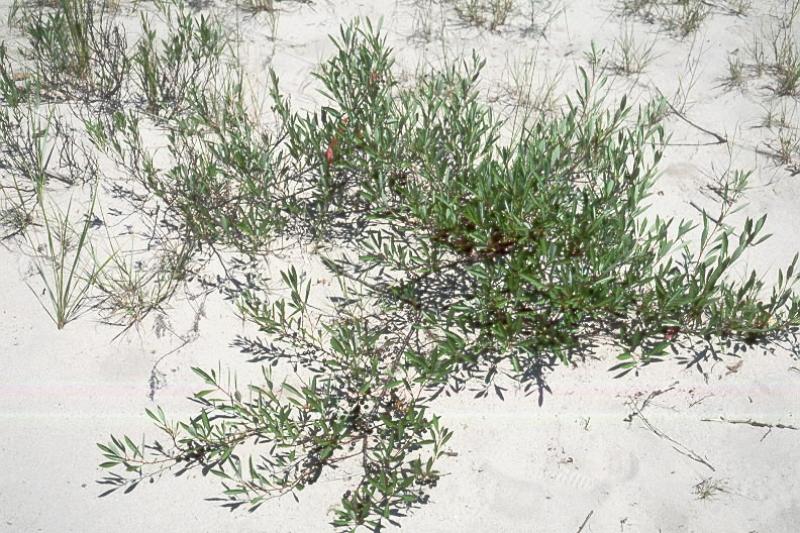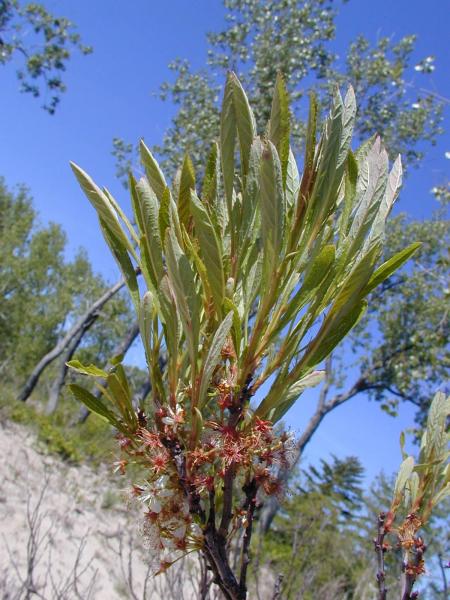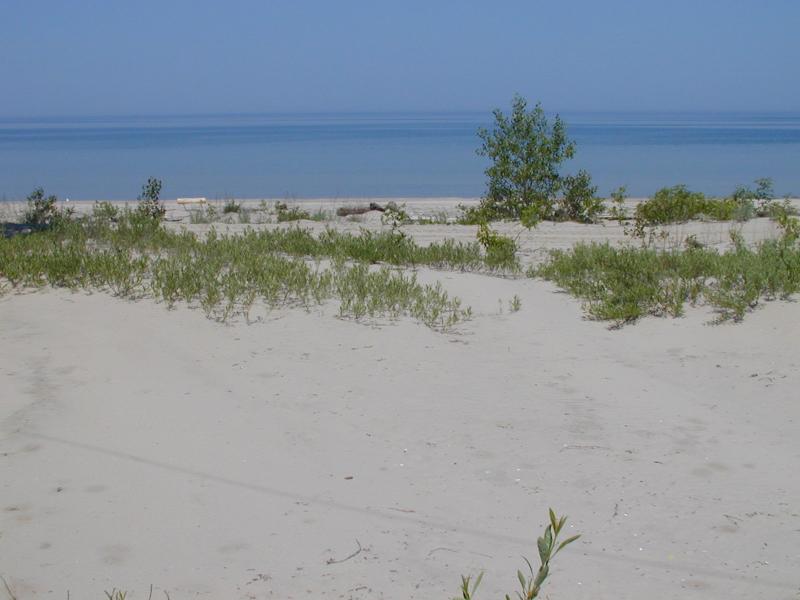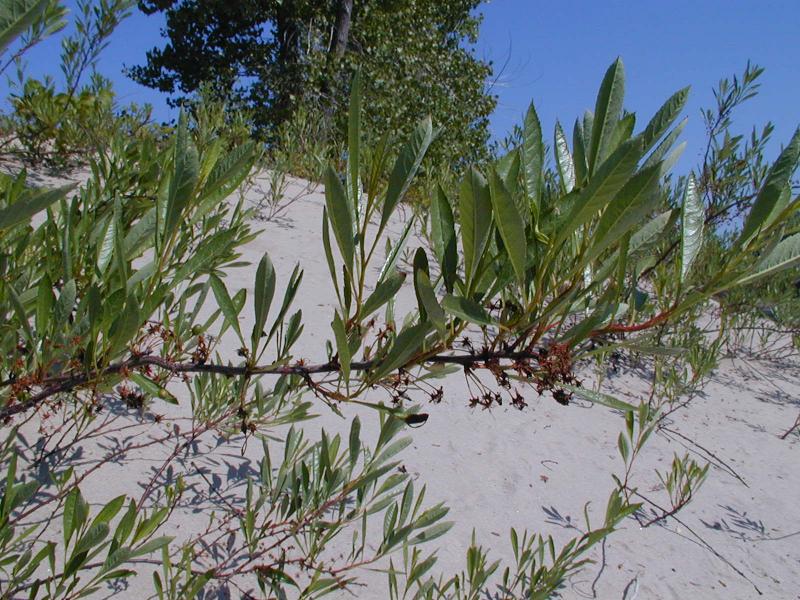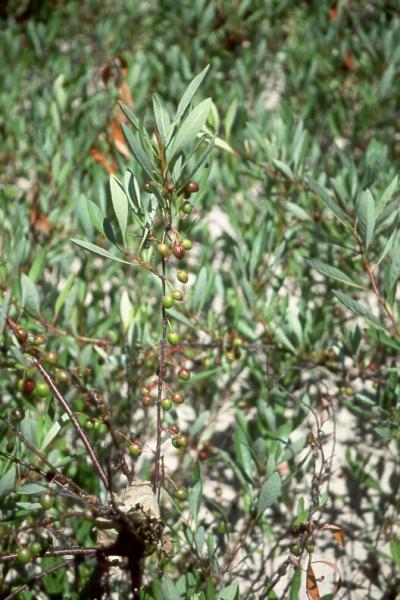Great Lakes Sand Cherry
Prunus pumila var. pumila None
- Class
- Dicotyledoneae (Dicots)
- Family
- Rosaceae (Rose Family)
- State Protection
- Endangered
Listed as Endangered by New York State: in imminent danger of extirpation in New York. For animals, taking, importation, transportation, or possession is prohibited, except under license or permit. For plants, removal or damage without the consent of the landowner is prohibited.
- Federal Protection
- Not Listed
- State Conservation Status Rank
- S1
Critically Imperiled in New York - Especially vulnerable to disappearing from New York due to extreme rarity or other factors; typically 5 or fewer populations or locations in New York, very few individuals, very restricted range, very few remaining acres (or miles of stream), and/or very steep declines.
- Global Conservation Status Rank
- G5T4
Apparently Secure globally - The subspecies/variety is uncommon in the world but not rare; usually widespread, but may be rare in some parts of its range; possibly some cause for long-term concern due to declines or other factors. (The species as a whole is common globally.)
Summary
State Ranking Justification
There are 5 verified occurrences, 5 historical occurrences, needs taxonomic work.
Conservation and Management
Threats
ORV traffic.
Habitat
Habitat
In New York Low Sand-cherry has most often been found on open sand areas on dunes along Lake Ontario, and occasionally also found in other open sandy habitats (New York Natural Heritage Program 2011). Sand dunes and sandy soil, especially on the shores of the Great Lakes (Gleason and Cronquist 1991). Active sand dunes, especially along the shores of the Great Lakes; in both wet and dry habitats; open sandy, gravelly, or bouldery beaches of lakes and shores of rivers, in crevices of rock faces and ridges; on sand dunes, flats and barrens, also in sedge mats of bog and fens and in wet depressions between dunes (Soper 1982). Dunes and sands or calcareous rocky shores (Fernald 1970).
Associated Ecological Communities
- Great Lakes dunes
(guide)
A community dominated by grasses and shrubs that occurs on active and stabilized sand dunes along the shores of the Great Lakes. Unstable dunes are sparsely vegetated, whereas the vegetation of stable dunes is more dense, and can eventually become forested.
- Sand beach
A sparsely vegetated community that occurs on unstable sandy shores of large freshwater lakes, where the shore is formed and continually modified by wave action and wind erosion. Characteristic species that are usually present at very low percent cover include various grasses and other herbs.
Associated Species
- Ammophila breviligulata (beach grass)
- Artemisia campestris ssp. caudata (sand wormwood)
- Carex lenticularis (lake shore sedge)
- Cladium mariscoides (twig-rush)
- Cornus sericea (red-osier dogwood)
- Festuca rubra
- Populus deltoides
- Populus grandidentata (big-toothed aspen)
- Prunus virginiana
- Rhynchospora capitellata (brownish beak sedge)
- Salix cordata (sand-dune willow)
- Toxicodendron radicans
- Vitis riparia (river grape, frost grape)
Range
New York State Distribution
Great lake sand dunes.
Identification Comments
Identifying Characteristics
Distinguishing characteristics: low or trailing shrub; stem erect; erect or strongly ascending or sometimes decumbent branches and branchlets; diffusely branched; leaves narrowly oblanceolate, tapering gradually from near or above the middle to the narrowly cuneate base and slender petiole (1-1.5cm long) to the acuminate apex; blade mostly 4-7.5cm long and 0.6-1.5cm broad, coriaceous, dark green and lustrous above, slightly paler but scarcely glaucous beneath, appressed-serrate above the middle; deciduous stipules 1.2-1.5cm long, thread-like, fimbriate or setose; purple to blackish cherry, 1.0-1.5cm in diameter; stone subglobose, apiculate at tip, rounded at base, 6-8mm broad. Best life stage for ID: in leaf with flowers or fruit. Characteristics needed to ID: stems, leaves, fruit.
Similar Species
Prunus pumila var. cuneata has leaves elliptic to oblong or narrowly obovate, blunt or merely short-acute, whitish beneath; stone acute, rounded at base, 5-6mm broad. Prunus pumila var. depressa has trailing branches, forming mats up to 2m across; leaves spatulate-oblanceolate to spatulate-obovate, pale beneath; stone ellipsoid, acute at both ends, 4.5-6mm broad.
Best Time to See
Low-Sand-cherry can be identified whenever it is in leaf, from May until early October.
- Vegetative
- Flowering
- Fruiting
The time of year you would expect to find Great Lakes Sand Cherry vegetative, flowering, and fruiting in New York.
Great Lakes Sand Cherry Images
Taxonomy
Great Lakes Sand Cherry
Prunus pumila var. pumila None
- Kingdom Plantae
- Phylum Anthophyta
- Class Dicotyledoneae
(Dicots)
- Order Rosales
- Family Rosaceae (Rose Family)
- Order Rosales
- Class Dicotyledoneae
(Dicots)
- Phylum Anthophyta
Additional Common Names
- Sand-cherry
Synonyms
- Cerasus pumila Michx.
Additional Resources
References
Fernald, M.L. 1950. Gray's manual of botany. 8th edition. D. Van Nostrand, New York. 1632 pp.
Gleason, Henry A. and A. Cronquist. 1991. Manual of Vascular Plants of Northeastern United States and Adjacent Canada. The New York Botanical Garden, Bronx, New York. 910 pp.
Holmgren, Noel. 1998. The Illustrated Companion to Gleason and Cronquist's Manual. Illustrations of the Vascular Plants of Northeastern United States and Adjacent Canada. The New York Botanical Garden, Bronx, New York.
Mitchell, Richard S. and Gordon C. Tucker. 1997. Revised Checklist of New York State Plants. Contributions to a Flora of New York State. Checklist IV. Bulletin No. 490. New York State Museum. Albany, NY. 400 pp.
New York Natural Heritage Program. 2024. New York Natural Heritage Program Databases. Albany, NY.
Reschke, Carol. 1990. Ecological communities of New York State. New York Natural Heritage Program, New York State Department of Environmental Conservation. Latham, NY. 96 pp. plus xi.
Soper, James H. and Margaret L. Heimburger. 1982. Shrubs of Ontario. The Royal Ontario Museum, Toronto, Canada, 495P.
Weldy, T. and D. Werier. 2010. New York flora atlas. [S.M. Landry, K.N. Campbell, and L.D. Mabe (original application development), Florida Center for Community Design and Research http://www.fccdr.usf.edu/. University of South Florida http://www.usf.edu/]. New York Flora Association http://newyork.plantatlas.usf.edu/, Albany, New York
Zaremba, Robert E. 1991. Corrections to phenology list of April 9, 1991.
Links
About This Guide
Information for this guide was last updated on: August 10, 2011
Please cite this page as:
New York Natural Heritage Program. 2024.
Online Conservation Guide for
Prunus pumila var. pumila.
Available from: https://guides.nynhp.org/great-lakes-sand-cherry/.
Accessed July 26, 2024.
